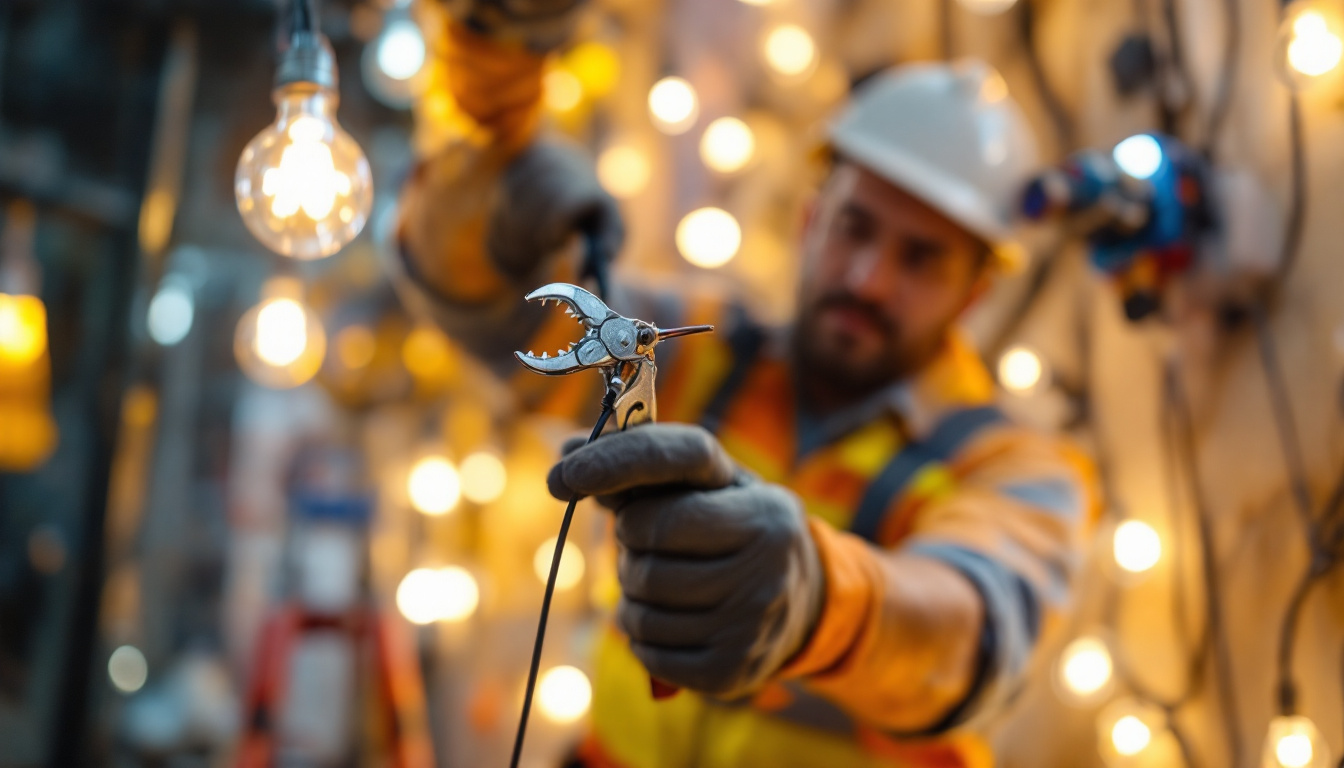
In the world of lighting design, industrial pendant light fixtures have emerged as a staple for both functionality and aesthetic appeal. These fixtures not only illuminate spaces effectively but also add a unique character to various environments, ranging from warehouses and factories to modern homes and restaurants. For lighting contractors, understanding the nuances of industrial pendant lights is essential for delivering quality installations that meet client expectations. This handbook aims to provide a comprehensive overview of industrial pendant light fixtures, covering their design, installation, and maintenance.
Industrial pendant lights are characterized by their robust construction and utilitarian design. Typically suspended from the ceiling by a chain or rod, these fixtures are designed to provide focused illumination while contributing to the overall industrial aesthetic. The materials used in their construction often include metal, glass, and sometimes even wood, allowing for a diverse range of styles that can complement various interior designs.
One of the defining features of industrial pendant lights is their versatility. They come in various shapes, sizes, and finishes, making them suitable for different applications. Common designs include dome-shaped, cage-style, and vintage-inspired fixtures. The choice of materials also plays a significant role in their functionality; for instance, metal shades can enhance durability while glass shades can soften the light output.
Another important aspect is the type of light source used. Many industrial pendant lights are compatible with LED bulbs, which offer energy efficiency and longer lifespans compared to traditional incandescent bulbs. This compatibility is crucial for contractors looking to provide sustainable lighting solutions.
Industrial pendant lights are not limited to traditional industrial settings. They have found their way into residential spaces, restaurants, and retail environments. In homes, these fixtures can serve as statement pieces over kitchen islands or dining tables, adding a touch of modern elegance. In commercial settings, they can illuminate workspaces or enhance the ambiance of dining areas.
Understanding the specific application is vital for lighting contractors. For example, in a restaurant, the lighting needs to create a warm and inviting atmosphere, while in a workshop, the focus may be on providing bright, functional light. Each application requires a tailored approach to fixture selection and placement.
Selecting the appropriate industrial pendant light fixture involves several considerations. Lighting contractors must take into account the space’s size, the desired ambiance, and the specific tasks being performed in the area. Here are some key factors to consider when making a choice.
The size of the pendant light should be proportionate to the space it will occupy. A large, bold fixture can serve as a focal point in a spacious room, while smaller fixtures may be more appropriate for intimate settings. Additionally, the height at which the fixture is hung can influence its effectiveness. A general rule of thumb is to hang pendant lights 30 to 36 inches above a dining table or kitchen island to ensure optimal illumination.
The style of the pendant light should align with the overall design theme of the space. Industrial pendant lights often feature finishes such as matte black, brushed nickel, or antique brass, which can enhance the industrial vibe. However, incorporating elements like wood or colored glass can soften the look and make it more inviting. Contractors should consider the existing decor and select fixtures that complement the overall aesthetic.
Another crucial factor is the light output. The lumen rating of the bulb used in the pendant light will determine how much light is emitted. For task-oriented areas like kitchens or workshops, higher lumen outputs are necessary, while ambient lighting may require softer, lower outputs. Additionally, opting for LED bulbs can significantly reduce energy consumption and maintenance costs, making them an ideal choice for contractors aiming for sustainability.
Proper installation of industrial pendant light fixtures is critical for both safety and functionality. Lighting contractors must adhere to local building codes and safety standards while ensuring that the fixtures are securely mounted and properly wired. Here are some essential installation considerations.
Before installing any pendant light, it is essential to assess the electrical requirements. This includes checking the voltage and ensuring that the circuit can handle the load of the new fixture. Contractors should also consider the placement of electrical boxes and whether additional wiring is needed to accommodate the new installation.
In some cases, it may be necessary to consult with an electrician to ensure that all electrical work is compliant with local regulations. This step is especially important in commercial settings where safety standards are more stringent.
Industrial pendant lights can be mounted in various ways, depending on the design of the fixture and the ceiling type. For instance, fixtures that are heavier may require additional support or reinforcement to ensure stability. Contractors should also consider the length of the suspension chain or rod, as this can affect the overall look and functionality of the light.
Additionally, ensuring that the fixture is level and correctly aligned is crucial for aesthetic appeal. Taking the time to measure and adjust during installation can prevent future issues and enhance the overall appearance of the lighting design.
Safety should always be a top priority during installation. Contractors should wear appropriate personal protective equipment (PPE) and ensure that the power is turned off before beginning any electrical work. Using insulated tools and following proper lifting techniques can help prevent accidents and injuries.
After installation, it is advisable to test the fixture to ensure it operates correctly and safely. Checking for any flickering lights or unusual sounds can help identify potential issues before they become significant problems.
Regular maintenance is essential for ensuring the longevity and performance of industrial pendant light fixtures. Proper care not only enhances the appearance of the fixtures but also ensures that they continue to function efficiently. Here are some maintenance tips for lighting contractors to consider.
Over time, dust and grime can accumulate on pendant lights, affecting their brightness and overall appearance. Regular cleaning is necessary to maintain the fixture’s aesthetic appeal. Contractors should recommend using a soft, damp cloth to wipe down the surfaces of the light, avoiding harsh chemicals that could damage the finish.
For fixtures with glass components, using a glass cleaner can help restore clarity and shine. It’s important to ensure that the fixture is turned off and cool before cleaning to prevent any accidents.
As with any lighting fixture, bulbs will eventually need to be replaced. Contractors should educate clients about the lifespan of the bulbs used in their industrial pendant lights and provide guidance on how to safely replace them. This includes turning off the power, allowing the bulb to cool, and using gloves to handle the new bulb to avoid transferring oils from the skin.
In addition, discussing the benefits of LED bulbs, such as energy efficiency and longer lifespans, can encourage clients to make informed choices about their lighting solutions.
Conducting periodic inspections of industrial pendant light fixtures can help identify potential issues before they escalate. Contractors should check for signs of wear, such as frayed wires, loose connections, or damaged fixtures. Addressing these issues promptly can prevent safety hazards and ensure the continued effectiveness of the lighting.
Establishing a maintenance schedule can help clients stay on top of their lighting needs and prolong the life of their fixtures. This proactive approach can also enhance the contractor-client relationship by demonstrating a commitment to quality service.
The world of lighting design is constantly evolving, and industrial pendant lights are no exception. Staying updated on the latest trends can help lighting contractors offer innovative solutions to their clients. Here are some current trends in industrial pendant lighting.
One of the most notable trends is the mixing of materials. Combining metal with wood, glass, or even fabric can create unique and visually striking fixtures. This approach allows for greater customization and can help clients achieve a look that is distinctly their own.
Contractors should explore options that incorporate these mixed materials, as they can appeal to clients looking for something beyond traditional industrial designs. For instance, a metal fixture with wooden accents can soften the harshness often associated with industrial lighting.
As technology continues to advance, the integration of smart lighting solutions into industrial pendant fixtures is becoming increasingly popular. Smart bulbs and fixtures can be controlled via smartphone apps or voice commands, offering convenience and flexibility for users.
Contractors who are knowledgeable about smart lighting options can provide clients with modern solutions that enhance the functionality of their spaces. This trend not only improves user experience but also promotes energy efficiency through features like scheduling and dimming.
Vintage and retro styles are making a comeback in industrial pendant lighting. Fixtures that mimic the look of antique designs, such as Edison bulbs and cage-style shades, are gaining popularity in both residential and commercial settings.
Contractors should consider offering a selection of these vintage-inspired fixtures to appeal to clients seeking a nostalgic aesthetic. These designs can add warmth and character to spaces, making them feel more inviting.
Industrial pendant light fixtures are a versatile and stylish choice for a wide range of applications. For lighting contractors, understanding the intricacies of these fixtures—from selection and installation to maintenance and current trends—is essential for delivering exceptional service. By staying informed and adapting to client needs, contractors can ensure that they provide lighting solutions that not only meet functional requirements but also enhance the overall aesthetic of the spaces they illuminate.
As the demand for industrial pendant lights continues to grow, contractors who are knowledgeable and proactive in their approach will be well-positioned to succeed in this dynamic field. Embracing the unique characteristics of industrial lighting can lead to innovative designs that not only satisfy clients but also elevate the art of lighting design.
Ready to elevate your lighting projects with the finest industrial pendant light fixtures on the market? Look no further than LumenWholesale, where we provide lighting contractors with spec-grade products that combine quality and affordability. Our expansive selection is designed to meet rigorous industry standards, ensuring you deliver exceptional results every time. Say goodbye to local distributor markups and hello to unbeatable wholesale prices, complemented by the convenience of free shipping on bulk orders. Take the first step towards a brighter future in lighting design and experience Wholesale Lighting at the Best Value today.

Discover how the innovative work light bulb can revolutionize your bidding strategy as a lighting contractor.

Discover how exterior hanging lights are revolutionizing the work of lighting contractors by enhancing efficiency and aesthetics.

Discover the essential insights and strategies for lighting contractors in “Wire Pullers: The Points for Lighting Contractors.” This article delves into the latest industry trends, innovative techniques, and practical tips to enhance your projects and boost client satisfaction.

Discover the ultimate guide to Floodlight Solar, where lighting contractors can find top resources and expert tips for mastering solar-powered lighting solutions.